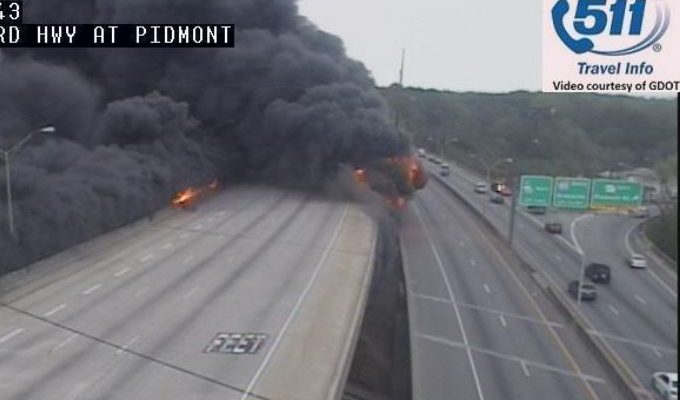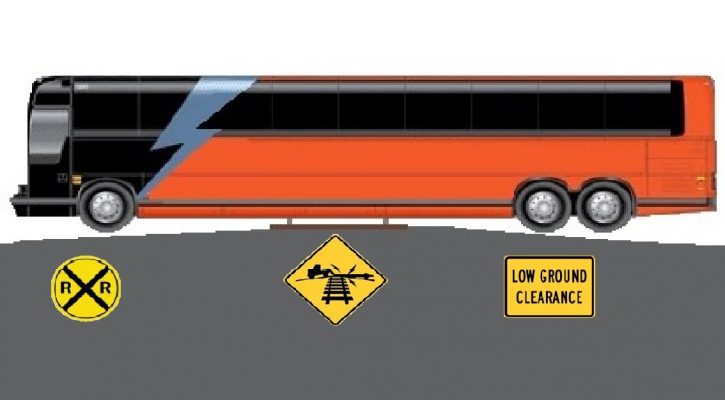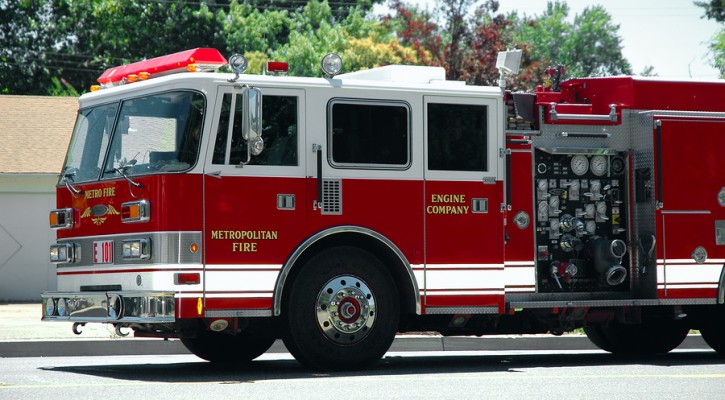Tag Archive: Road rules

To My Friends In Atlanta
March 31, 2017
The City of Atlanta suffered a crippling fire yesterday that’s going to tie up traffic in the area for months to come. A large plastic tubing storage area underneath a bridge on Interstate 85 near downtown Atlanta caught fire and the resulting heat weakened the bridge structure causing it to collapse.
Highway officials and engineers say the damage isn’t limited to just the section of bridge that collapsed but also to adjacent roadways. The bridge collapse has shut down a major artery into downtown Atlanta that carries hundreds of thousands of cars each day. Since there’s no idea yet on the extent of the damage, there’s no word on how long repairs will take. Needless to say, Atlanta traffic is going to reach even greater nightmarish levels over the coming days and months.
In past articles, I’ve written nostalgically about my early days learning to drive in the City of Atlanta. For a while, I even worked as a tour guide, driving passengers in a small bus to all the interesting sights in and around the city. In those days, Atlanta drivers took great pride in their courtesy to each other. In fact, my tourists used to comment on how courteous the drivers were in Atlanta compared to their home cities. Those days are long gone!
The explosive growth of businesses in and around Atlanta brought millions of people from other parts of the country to Atlanta in search of jobs. The population of metro Atlanta swelled from just over a million people when I graduated from high school to almost six million today. Many of those transplants from other areas of the country brought their bad driving habits with them and the folks with bad driving behaviors soon supplanted the older, more courteous native Atlantans.
Their driving behavior became so bad that Atlanta is now listed among the top cities with the worst aggressive drivers and road rage incidents according to periodic surveys by AutoVantage, an online insurance company. In fact, Atlanta passed New York and Miami in the road rage rankings.
The collapse of the I-85 bridge is going to test Atlantans in ways not seen since General Sherman’s visit in 1864. If Atlantans stick to their current driving behaviors there’s going to be a lot of chaos on Atlanta roadways. There are going to be a lot more incidents of road rage, car crashes, and, unfortunately, a lot more deaths and injuries than normal.
The only way Atlantans are going to make it through this intact is if they fall back on those old fashioned driving behaviors exhibited by Atlantans many years ago. That means;
- obeying the speed limits,
- no tailgating,
- no cutting into the front of long lines of traffic,
- no trying to beat the yellow light,
- no running red lights, and
- keeping intersections clear.
It even goes so far as to mean allowing other drivers to enter the roadway ahead of you. Allowing another driver to enter the road in front of you costs very little time and will avoid those dangerous maneuvers by drivers trying to force their way into traffic.
If Atlantans were to try this radical new idea, they’d probably be very surprised to find that traffic will flow much more quickly and smoothly. It’s the smartest and safest thing to do. If not, they should run to their hairstylist, get a Mohican haircut, put on the spiked hubcaps, and mount the harpoons and mini-Gatling guns to the hoods of their vehicles because it’s going to be just like a Mad Max movie.

Pay Attention To RR Crossing Warning Signs!
March 8, 2017
All too often, drivers either ignore railroad crossing warning signs or assume the warning doesn’t apply to them. Yesterday, four people lost their lives and seven people were critically injured after a bus that was stuck on railroad tracks was hit by a train.
This wasn’t the first crash involving a stuck vehicle and a train at that railroad crossing. Just two weeks ago, a Pepsi delivery truck became stuck at the same crossing but, fortunately, no one was injured in that crash.
Many railroad grades have steep sides that make it dangerous for vehicles such as semi-trailers and buses that have very little ground clearance. Even some cars that have been modified can become stuck at these crossings.
One of the mistakes made in this instance was that the bus driver failed to immediately evacuate the bus as soon as he became stuck. Instead, a few people got off but most remained onboard while the driver tried to move his bus off the tracks. Had the bus been evacuated and the people moved far away from the tracks, the loss of life and injuries could have been minimized.
It’s important to remember that a fully loaded freight train carrying a lot of weight can take up to a mile before it can be brought to a complete stop. When approaching railroad crossings, look at and pay attention to all of the warning signs. If you think your vehicle may not make it across, turn back and look for another nearby crossing.
For more information visit: 4 dead after train, bus collide in Biloxi, Mississippi

Decoy Used To Enforce Move Over Law
November 18, 2014
Police in Woodbridge New Jersey recently used a decoy fire truck to enforce that state’s Move Over Law. In spite of the fact that a large fire truck with its emergency lights flashing was posted on the road’s shoulder, many motorists paid no heed and refused to slow down or move to the far lane.
The first Move Over Law in the US was enacted in 1996 and, as of 2012, all 50 states have some form of Move Over Law that requires motorists to move over into the opposite lane or, if they can’t move over, to slow down when they encounter emergency vehicles on the side of the road. In spite of the law, according to estimates, law enforcement officers are killed by the side of the road at a rate of one per month and approximately five firefighters per year are killed. Surprisingly, tow truck operators are killed at an even greater rate.
New Jersey’s law was enacted in 2009 and requires that motorists who can’t move over into the opposite lane slow “to a reasonable and proper speed for the existing road and traffic conditions, which speed shall be less than the posted speed limit, and be prepared to stop.” The law not only includes police and fire vehicles but also tow trucks, highway maintenance, and service vehicles that are displaying emergency flashing lights.
This year, Florida amended its Move Over Law to include garbage/sanitation trucks and utility (gas, electric, water) vehicles in addition to police, fire, and tow trucks. Under Florida’s law, motorists who can’t move over are required to slow down at least 20 mph under the posted speed limit.
Enforcement or Entrapment?
In planning for the use of the fire truck decoy, Woodbridge police set up rules:
- A Move Over Law education program using billboards began on the routes in question several months before the start of the enforcement program.
- The fire truck was placed on on a straight section of road where a traffic light before the fire truck provided a natural break in traffic.
- Officers had to verify vehicle speed with a laser gun.
- Only vehicles that had a clear break in traffic to safely move over or slow down were monitored.
Fortunately, the majority of motorists that were monitored did slow down or move over. Unfortunately for some, the only way to get their attention is by issuing a traffic ticket. The first driver cited for failure to obey the law was traveling at 62 mph and made no effort to move over or slow down.
With the holidays approaching and the roads filled with travelers and shoppers, emergency personnel will be out on the roads in force. Protect the ones that protect you by obeying the Move Over law. Read more: Police use ‘decoy’ firetruck to educate drivers on Move Over law

Ask The Traffic School Instructor: Backing Out Of A Parking Spot
November 12, 2014
Question: I was backing out of a parking spot and couldn’t see due to a large van parked next to me. Even though I was backing very slowly and carefully, I was hit by another car. Who’s at fault in this crash?
Answer: Technically, the driver who will be held at fault in a situation like this will be the driver who is backing out of the parking spot.
In looking at the Florida Statutes, the law simply says “The driver of a vehicle shall not back the same unless such movement can be made with safety and without interfering with other traffic.” That puts the responsibility of preventing a crash on the shoulders of the person backing out of the parking spot.
However, that being said, the true blame can probably be equally shared among the two drivers. Florida law also says the law doesn’t relieve anyone “from the duty to drive with due regard for the safety of all persons, nor shall such provisions protect the driver from the consequences of his or her reckless disregard for the safety of others.”
If the other driver was driving too fast or not paying attention, he or she shares in the blame. When driving in a parking lot, drivers should drive slowly, be on the lookout for anyone who may back out in front of them, and be prepared to stop quickly to avoid a crash. Even though the other driver may share in the blame, the person backing out will probably be the only one to get a ticket for failure to use due caution.
Remember that no one has the right-of-way. The law only tries to determine who should have yielded the right-of-way to another driver. The person backing out should yield the right-of-way to the drivers in the travel lanes but those drivers in the travel lanes should also be prepared to yield to prevent a crash.

Ask The Traffic School Instructor: Is it legal to turn left on a yellow light or not?
April 29, 2014
Question: I got a ticket for turning left on a yellow light; isn’t it legal to turn on a yellow light?
Answer: OK, this one gets a bit tricky and to explain it we first have to understand the concept of a “fresh or stale yellow light.” You can get a ticket for running a yellow light if you had time to stop safely. When an officer sees you making a turn on a yellow light, he or she will first determine whether or not you a fresh or stale yellow light.
Let’s say you were the first driver in the intersection when the light turned green and you pulled out into the intersection to turn but oncoming traffic prevented you from turning safely and you couldn’t make your turn until the light turned yellow and oncoming traffic had stopped. In that case, you turned on a “fresh yellow light.”
Now, let’s say you were the second or third driver in line and couldn’t pull out into the intersection because the driver ahead was blocked from turning by oncoming traffic. If you didn’t enter the intersection until the light was about to or had already turned yellow, you had a “stale yellow light” and are guilty of running a yellow light. In this case, instead of turning on the yellow light, you should wait behind the line until the light turns green again before entering the intersection.
